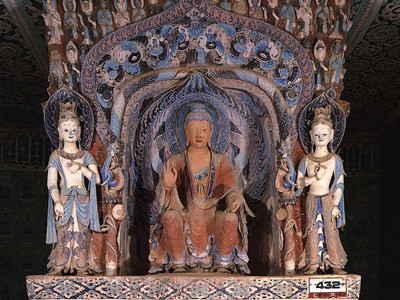Mogao Grottoes [ Related Itinerary ]
 Located 25 kilometers southeast of the Dunhuang City, on the bluff on the Echoing-Sand Mountain, Mogao Grottoes is regarded as the most valuable cultural discovery in the 20th century and was listed as the World Heritage Site by the UNESCO in 1987. As one of the Four Greatest Grottoes of China, it is also the largest and most well-preserved treasure of Buddhist culture in the world.
Located 25 kilometers southeast of the Dunhuang City, on the bluff on the Echoing-Sand Mountain, Mogao Grottoes is regarded as the most valuable cultural discovery in the 20th century and was listed as the World Heritage Site by the UNESCO in 1987. As one of the Four Greatest Grottoes of China, it is also the largest and most well-preserved treasure of Buddhist culture in the world.According to the historical records, the Mogao Grottoes was started to build in 366 during the Sixteen Kingdoms Period (304-439) and lasted for almost 1500 years to be finished. With such a long history and the hard work in different dynasties, the Mogao Grottoes is regarded as a sacred land of Buddhism. The earliest caves were built during the Northern Wei (386 - 535), Western Wei (534 - 557) and Northern Zhou (557 - 581) Periods, with the characteristics of distinctive Indian designs and majestic colors. The Sui Caves were built during the Sui Dynasty (581 - 618), with the characteristics of distinctive traditional Chinese design. The Tang Dynasty (618 - 907) is the boom period for Mogao Grottoes. Half of the 500 caves in the grotto were created during the Tang Dynasty and one of the largest Buddhas is 35 meters tall. Also since the development of traditional art, the statues in the grottoes are much more delicate and beautiful.
Mogao Caves are commonly known as the Caves of a Thousand Buddhas. Stretching of over 1600 meters from south to north, today in the Mogao Grottoes, visitors still could see 735 well-preserved caves with 4.5 square meters murals, 2415 colored clay statues and more than 50,000 historical relics. The largest statue is 34.5 meters high while the smallest one is only 2 centimeters high. The painted clay figures and the murals in Mogao Caves show the absorption of the merits of western ancient arts from India, Greece, Iran, etc.
Being the largest, longest and richest art gallery of Buddhism in the world, the Mogao Grottoes is a brilliant pearl in the Chinese art treasure troves and it is the must-see place during Dunhuang tour. Also a new museum attached to Mogao Grottoes has been opened to the public, where visitors can see the copies of the murals from Mogao Grottoes inside.
Related Itinerary